
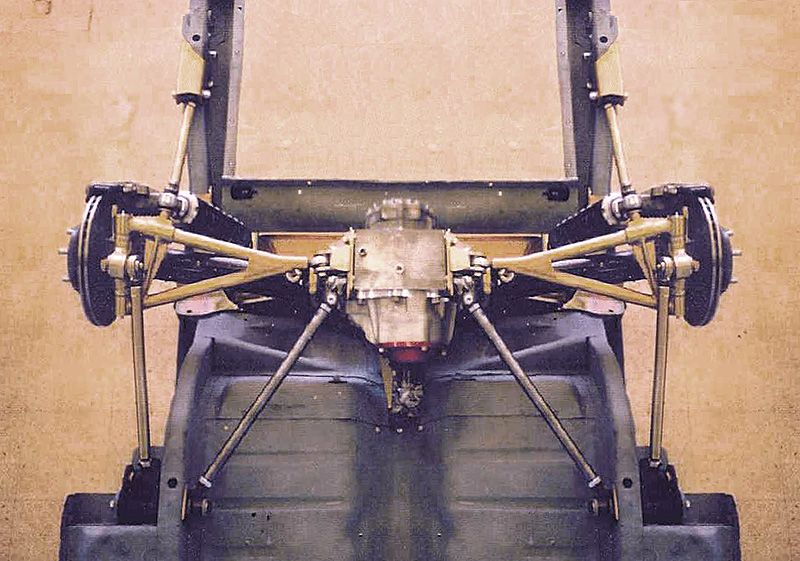
 |
 |
 |
 |
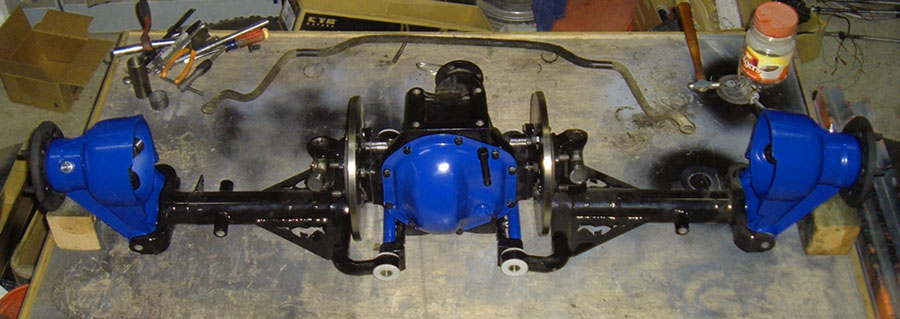 |
You are not logged in. Would you like to login?
![]() Offline
Offline

I guess that is a shock. I thought it was maybe some type of urethane/something other than a shock thingy. Is that a protective sleeve over the shaft?
Ralphy
![]() Offline
Offline
I think I'll have room for a radius rod... asssuming longer is better to minimize the effect of the arc it'll move in... likely will be able to run it from the UCA to the front hanger where the solid axle leaf springs used to hang.
![]() Offline
Offline
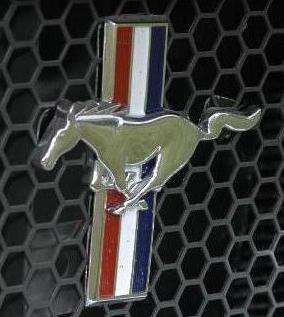
The radius rod should pivot at the inner fulcrum of the upper arm. This essentially makes the upper arm into an A arm.
Last edited by irstang (5/07/2013 8:08 am)
![]() Offline
Offline
OK, that makes sense. Presumably longer is still better. By inner fulcrum you're saying on a plane parallel to the center line if the car (front to back) and intersecting the upper arm's pivot point, right?
Now, if I have to make a choice between doing that where it's only a few degrees off the existing UCA (maybe ending only a few inches forward of the UCA inner pivot or more of a forward link like the FFR pics (but true radius rod) which would be preferable and why?
There's very little room in that area to work with.
![]() Offline
Offline

In answer to your first question, this is correct if the plane is parallel to the inner pivots of the lower control arm.
Locate the inner pivot of the radius rod on an axis through the upper inner arm pivot. This axis should be parallel to the lower arm inner pivots both horizontally and vertically. Looking at your pictures, you may have more room running the rod aft. This would put the rod under tension during accelleration, which is good.
A few inches forward won't do much good, but it would be a good start for a forward pivot of a A arm, with the rear pivot toward the back. The further these pivots are apart the better.
Without talking to some Ford Mustang drag racers, I don't know if the FFR shocks work or not.
![]() Offline
Offline

rficalora,
Look at it this way, assume your going to install a upper control arm/ A arm. That A arm will have to to in a specific location to avoid any bind with the lower. The link has to be in the exact same place. Parallel to the LCA's inner pivot points also pivot points equal to the existing upper link.
Taken from post #18
"Some may disagree, but the coilover to the front may be a big issue wrapping up the LCA. Your suspension is all Heimed out, that's good no rubber. I just read tire sidewalls could be an issue. Maybe pump about 80 psi into them and see what happens. Another IMO, I think you could add another link behind your UCA. Triangulating the upper, making the inner mount of elongated and radiused, like so ). Setup the camber and toe etc... with it unattached. once set with the car jacked up with coilover out reattach the link and cycle the suspension up and down by hand. Trust the feel, IMO the bind would be zero to little. This would allow for no need tomove the coilover? Hmmm?"
Ralphy
Last edited by Ralphy (5/08/2013 3:53 am)
![]() Offline
Offline

Looking at your upright, it seems to me it could use a bit of strengthening also. No reinforcement to avoid twisting!
Ralphy
Last edited by Ralphy (5/09/2013 5:33 am)
![]() Offline
Offline

I'm going to beat a dead horse. LOL!
Look at this design, now flip it upside down. Then instead of hard attaching the trailing link, use Heims at both ends. The inner mount of the trailing link is not random it's at a position where you will have no fore or aft motion. No bind! It doen't mater where the outer point mounts, other than the further out the stronger. You can go forward or back with the links inner point. Your monting points should be parallel horizontal and verticle with your LCA. Unlike an IFS you have a hard/fixed point on your LCA. If you go forward you'll have to clear the coilover of course.
Ralphy
Last edited by Ralphy (5/09/2013 6:11 am)
![]() Offline
Offline
Oh new and shiny stuff. Rather than ask where to find one (not that I need or even have a dream for one), I'll drool over it a bit ![]()
![]() Offline
Offline
It's been a couple of weeks, thought I'd give a quick update... wheel hop must have been related to the bad hub as now that I've fixed that, I'm no longer getting it. More and more I'm thinking I inadvertantly put one of my used hubs back on when i replaced them about a year ago. Thinking I've had a bad hub from the start and it just got worse over time.
As for the uprights twisting, I doubt it. They are 1/2" plate and are a double layer welded around the perimeter where the stub axle comes through - which is one of the reasons i want to re-do them... let's say they are not light.
![]() Offline
Offline
Ok, now that I'm past the hub & wheel hop issues, I want to start thinking about reworking portions of the IRS itself. Initially, my goals are:
a) to enable use of wider tires
b) likely to replace the bushings with something stiffer &/or heims to eliminate (minimize?) changes in camber or toe due to bushing "compliance".
b) to lighten it
c) to make it easier to align
And, before I start changing anything, I want to determine how good or bad the geometry is so I can address if I need to at the same time.
That all means I need to learn. What books or articles do you guys recommend?
![]() Offline
Offline

Books
Ralphy
![]() Offline
Offline
The upright you have is pretty skimpy looking when compaired to the GM front spindle the bearing was designed to be bolted to. The S 10 spindle clearly supports the bearing and doesnt allow the load distort the flatness of the mounting surface. The plate steel upright you have looks so light that it appears the bearing is supporting the plate. The load when applied to your three bolt pattern would distort the plate. The original would never allow this to happen. Discussing the torque is pointless when you consider the two inner races contact each other when torqued. 180 ft/lbs is nothing and is no where near what would be required to distort the hard bearing material. Tear one of one of your bad bearings apart and you will see how unlikely it is that the torque could distort anything. If your bearing flange had more bolts around the outside It may be able to provide the support the upright cannot. Just because your upright is not showing any worpage when you have it apart on your bench means little. That only means you havent distorted it past the point of plasticity. That doesnt mean it isnt distorting enough to harm the bearing with every bump or accelleration. I am well aware the car is light. That will help some but the 5.0l engine should be able to thrust the vehicle forward and create a greater load and distortion than the distortion generated from bumps.. That type bearing was never designed to support the upright. The upright should be ridgid enough to support the bearing. The way your upright its trimed down to a similar shape as the bearing with out any ribing perpendicular to the plate looks to me like a design flaw. In my opinion is the source ir your problem. The torque on your axle nut is to keep the inner races from ever seperating under load. If they seperate and go out of parallel they will begin to fail. You could torque your axle nut till the threads are on the verge of stripping and that will not squish the inner races enough to create the problem you are faced with. There is just way too much steel that is way too hard to distort from compression applied by the axle nut. . I am sure your axle nut could be torqued any where from 100ft/lb to 200ft/lb and work fine. Seems to me I thought the uprights were the problem before. Since I wasnt aware they were a flange mount bearing I was ignored. Ralphy said they were self contained as if that ment anything. Old Subaru front wheel bearings are the only ones I have come across that were not self contained. With that one exception all front wheel drive axle bearings are self contained and internally identical in desigh to the S 10 units. They all have the preload set by the manufacturer. The first 10 ft/lbs torque sets the bearings preload by squeezing the two inner races together.. The additional torque does not add any more preload on the bearing. The only difference between the press in bearing and the S 10 bearing with its flange is the flange and its 3 bolt mount .Even though its a red herring, All of them will have a axle nut torque above 100ft/lbs. Isnt Phantom Jock an engineer? he should be able to work out the loads on the upright quite easly with simple statics.and some strength of material equasions. Even guessing at the engines out put. All of the other required information would be easly obtained. If he is an engineer.
![]() Offline
Offline
Hi Tyrellracing - I hope you dontnthink I intentionally ignored input from you or anyone else. You guys know so much more than me I think some of the comments are above my head and I don't always catch it.
On the uprights, they are 3/8" plate with 1/2" plate welded to that around the perimeter. Not sire if that's visible in the pics (I'm on my phone and can't see the detail). I'll post some better pics of them when I have it apart this weekend, but given that info, does it still seem likely that the uprights are distorting? Or maybe they got distorted when the 1/2" plat was welded (TIG) to them?
Thanks again!
![]() Offline
Offline
The view I could see looks like just a 3/8 plate. For the ridgidity you should have a piece of flat stock around the entire perimeter. In a horse shoe shape from bushing to bushing. The flex is occurring in a direction you have no support. Only having three bolts holding it all together compounds the problem. Take a close look at how husky the S 10 spindle is compaired to what you have should drive the point home. The GM part is forged steel and therefore far more ridgid than mild steel that your upright is made out of. . Mild steel is soft when compaired to forged steel.. The S 10 spindle is expected to be used as a drive axle a small portion of the vehicles life. You have twice the HP that any S 10 had. Its unlikely you will get rid of this problem until you provide better ridgidity or change to a different type of bearing support entirely. If you look at Phantom jock's upright thread I dont recal seeing a single flange mount bearing in the group. The flat plate uprights all had ribs welded to them for strength in the direction your uprights need.. yours and the S 10 are the only ones I have seen that uses a flange mounted bearing. The S 10 is a lighter load application than an IRS behind a 5.0.so the bearings may not be up to the task. All of the others use a pressed in bearing plus they tend to lend them selfs to running more back spacing for wider wheels. Trying to make what you have work with only three bolts holding it on will be a continous problem. The bolts are not failing. Its the fact that the load is not spread out over a wide area. Is the half inch plate you were talking about sandwiched between the bearing and the 3/8 plate? It looks like your brake caliper mounting bracket is the 1/2" plate. If that is the case, That will only compound the problem by moving the bearing further from the 3/8" plate increasing the loading on that plate not supporting it. Anyway, best of luck Wheel bearing failures are a little more important than wheel hop. But your the one behind the wheel so.....
Last edited by tyrellracing (1/16/2014 4:00 am)
![]() Offline
Offline

If you put enough pressure on anything it will distort. Even a diamond I'm sure has a minut amount of plasticity before it shatters. The question is have you reached the tipping point? I'm suprised you haven't searched any S10 forums? I'm guessing you haven't since I'm finding warnings on quit a few of, over torque early failure. I see some saying 180 is a miss print it should be 130 or 105. Then others saying ft.lbs. should have been Nm. Going as low as 77 ft.lbs. Only way to find out, try it. You shouldn't be in any danger of parts falling off. Loctite?
"Wheel Hub and Bearing Assembly to Steering Knuckle Bolts (4WD Pickup and Utility)"
105 N·m
77 lb ft
"For your 95, you will want to torque the axle nut down to 133ftlbs (180Nm). The 97+ trucks are 103ftlbs (140Nm)."
Then let me repost this ad from fleebay.
Question: My 99 chevy blazer eats wheel hub bearings on a yearly basis. I also have replaced ball joints more than once. Why is this happening and why am I replacing my hub bearings so often?? Please help
1. If your vehicle is 4WD, one of the most overlooked and most common causes of wheel bearing failure is incorrect torque of the axle shaft nut. We are ASE techs who own a repair shop and we have also noticed that GM has changed some of the torques specs since factory. This has resulted in us concluding that GM may have realized the factory torque specs may have been incorrect or they have dialed them in closer to a more reliable setting. Most do-it-yourselfers do not have access to these updated specs or many time install them with an impact gun and this is a big no-no. Also you would be surprised how many techs actually install these with an impact gun and disregard the torque completely. Anyway I hope this helps reduce the number of hub bearings you replace. Other factors include oversize wheels and tires; other worn parts like ball joints can put excessive stress on bearings and other components, and improper maintenance. Thanks again and I hope this helps.
One more note, how accurate is your torque wrench? The mech's at our place have to check calibration every time they pick one up for the day.
As far as the upright, which was mentioned. Reenforcing would be a fairly simple fix if you weld or not.
Ralphy
Last edited by Ralphy (1/16/2014 3:33 pm)
![]() Offline
Offline
Ralphy: Have you ever replaced a bearing like the S 10 unit being discussed ? Have you ever replaced a plain front wheel drive wheel bearing?All of the wheel bearings used both foreign and domestic cars for drive axles that are not live axles in the last 20 years are self contained units with a single outer twin tapered bearing race and two seperate inner races held in by their seals. When they are installed and torqued the two inner races make contact with each other. When that occurrs the preload is set. Period. Its impossible to torque the axle nut tight enough to affect the bearing perload provided the engineer did his job right designing the parts. . The threads on the stub axle will strip or the stud will snap off before the pre load is affected. . Last time I checked, the torque that is applied to a threaded fastener is directly related to the thread diameted and its pitch. This is to create a streatch in the fastener. The manufacturers plan ahead and size the threads on the stub axle for the clamping force they want on the bearing to hold this critical hub assembly together.. The most likely cause of failure on the S 10 bearing would be a poorly engineered bearing for the application and the torque on the axle nut is their scape goat. Or maybe They put too big of a thread on the stub.for the clamping force required. They must put streatch on the stub to retain their nut. If they just back off the torque, they will loose streatch and amplify their problem because now the nuts will back off. That wasnt a solution. That was an ill conceved bandade. If the torque was reduced by the factory, the threads should have been reduced in size to maintain streatch. Phantom jock will know that. Any machinist would know that. Bolt streatch is 80% of what keeps the fastener from backing off. . Your machinerys hand book will also say that! . You do have one dont you? I have yet to meet a competent machinist that didnt own a Machinery's Hand book. The torque setting of a critical part is set by the diameter and the pitch to produce the ammount of streatch required. in the fastener. This torque measurment is cast in stone!. Period! Any reduction in torque must be acompanyed by a reducton in bolt size. There is no argueing this point I know its a fact and have thousands of engineers to back up my claim. If the factory reduced their torque and nothing else. They are openly admitting a serious problem in their design. That doesnt apply to any bearing problem but the one they created. That being the case the scape goat is the torque on the nut. The problem was their engineering and is much worse than what they are willing to let out. ASE will say anything that they are paid to say by any manufacturer.... There is always streatch available on the hardened stub axle holding the wheel bearing and flange together. Its difficult to compress the bearing races enough to produce a measureable difference in the bearings pre load. If it was true that over torquing were possible, it would be possible to lock or nearly lock up the wheel bearing by over torquing. Have you ever tried this or are you just believing the propaganda being spoon fed to you? You could put double the torque on the axle nut if the threads would hold up and still you would not have changed the bearing preload. The inner races are hard enough that the only part that would deform would be the splined stub axle. It is made of more elastic material than bearing.. I can cut stub axels with carbide on a lathe and have done so many times. You cannot cut a wheel bearing with anything but ceramic incerts. Why? because the alloy the bearing is made from is much harder and far more resistant to deformation. It can be deformed, but it will not compress axially with nothing but the axle nut to do it with. NOT GOING TO HAPPEN. This alloy is especially resistant to compression! .If it wasnt, it wouldnt make a very good bearing.... An axle nut will not be strong enough to compress the inner race on the S 10 wheel bearing no matter how bad you wish it did to prove a nonexistant point. If that was possible, you could lock up the bearing by overtorquing it.. The S 10 has an unusually large thread on their stub axle. at 28mm in dia its too big. 180ft/lbs is probably required to get the streatch required. If thats too much torque. The entire assembly should have been redesigned.Not just a reduction in torque. I have replaced hundreds of wheel bearings in fwd, 4x4's,irs, and a few odd ball Italian and Brittish bearing carriers. Yes there is always recomend a Torque for the axle nut . It will be the correct one for the thread size and pitch used.. The clamping force on the bearing is calculated by the engineer when he chose the thread size and pitch. It plays almost no role on the bearing preload. If the nut is left too loose the two inner bearing races can seperate. Like I said in a previous post the first 50ft/lbs torque sets the preload on the bearing. The resistance in rotating the bearing will not change from this torque up to final torque. The additional torque is to streatch the axle the desired amount. .The torque given in your video is wrong. The S 10 uses a 35 mm self locking flanged nut. No cotter pin or other locking device was observed.. The threadad end measures out at 28x2.00m. I have a pair of complete S 10 half shafts in my possesion for reference. How much streatch do you think their 95ft/lb torque was going to provide? My guess is the next video has their final torque. The 180 ft/lbs torque will not hurt anything but the arm pulling the torque wrench.
Last edited by tyrellracing (1/18/2014 12:11 am)
![]() Offline
Offline
. The number one reason for wheel bearing failure is the AXLE NUT BACKING OFF!!. The next is from the stub axel streatching.. Not from the factory failing to torque them right to begin with. . I dont care what you have been told it is never from overtorqueing them. Ever!! What are the chances that all of the of the factorys overtorqueing the damn things? There is very little chance of human error.. In nearly every case the torque is set in a powered torque wrench that cannot torque past the set level. If the OEM units didnt fail they wouldnt need to be replaced. RIGHT? What you are saying is all of the manufaturer are over torqueing the axle nuts on the vehicles they produce both foreign and domestic? Thats what would have to be happening if what you said the number one cause of failure was true. Or did you just make that up to cover what you were spewing before? They must all be wrong because you think you are right? I dont know who came up with that one but if you simply did a few tests measuring the bearing resistance to rotation at say 50 ft/lbs torque then at 150ft/lbs torque then at 200 ft/lbs torque you would see no difference in resistance. No change in resistance means no change in preload. It cannot change with out crushing the inner races. The axle will always streatch first. Its designed to do that. The threads will fail long before any change of significance occurrs. ASE my ass..
![]() Offline
Offline

Hey Tyrell stupid me! I guess I shouldn't post statements from ASE mechanics that have repaired these parts and S10 blazer forum administrators that made the statements. I mean you got it all together.
And as far as the twisting of the upright. If you go back to my post from months ago you will see I addressed that issue to him also way before your post. He seems to not want to or does not think that's a problem. So me thinking any improvement will help I actually researched for data. Stupid me!
Trust me I've seen enough odities in my life experiences that surprised me. 180 lbs. of torque is not not 180 lbs. of force on that bearing face, that's just the rotation lbs. It translates to app. 15,000 pounds of force from what I gather. And you can deform a flat solid oblect. I've seen material move in this exact situation when clamping materials I've cut. If you apply enough pressure on a piece of steel say clamping. The material will find a way to escape. It can't move up, it can't move down. So it will move left or right 90 degress. It's most noticeable on softer materials. However it does not go away just because it's harder. It only lessens. That's real experience I've had. Look at it like a really really hard sponge.
As far as being a self contained unit you missed that when originally, you started posting how you bored the diameter for out of roundness months ago, then vanished from this thread. You think I don't know that? Your the one who missed it from the get go. You went of on your maching angle. Get off my back!
Did you read their was a miss print possibly in the OEM repair manual? It wasn't a factory miss torque, it was a manual miss print Tyrell. So the factory bearings were torqued proper, issues came after replacement.
One mistake I may have made was to use the term plasticity. When I think I should have said elasticty.
Ralphy
Last edited by Ralphy (1/18/2014 12:16 am)
![]() Offline
Offline
You are not looking at the obvious problem Lots of ASE mechanics work on S 10's that doesnt make them engineers. Nor does that make them suitable to decide what the real problem is. They only report what they see with out any real schooling in the engineering that went into making that assembly function. There are some that are well schooled. Their problem is they will say what ever they are paid to say. The big three are their only real employer. They will not bite the hand that feeds them. Most are clueless why bolts are torqued other than to make them tight. Few realize that head bolts of different lengths will provide different clamping force with equal torque applied. Why? The longer the bolt the greater the elasticity. More elastic it is the less clamping force it will provide when the torque is equal.. The down side is the shorter bolts with little or no streatch will come loose due to a lack of streatch. Streatch is 80% of what keeps bolts from working loose. Head bolts on Chevy small blocks are a famous example. Thats why ARP necks down their shorter head bolts for the famous SBC. To let them all streatch the same ammount no matter what length they are. SBC's use three different length head bolts. SBF's have the same problem to a lesser extent with two different lengths. Many years ago I worked as a mechanic. I was/am ASE certified. That doesnt mean very much. I wasnt impressed with their training or how easy it was to get certified. UTI offers a better program.
![]() Offline
Offline
We are talking about some of the hardest steel alloy made. Its primary function is to resist compressive loads. They have to withstand this kind of load to be a bearing. They are not uncompressable. They just resist it better than any other type of steel alloy. The stub axle is designed to be streatched. only a few thousanths but thats all it takes. If the sutb axle was designed right the axle nut will provide the proper clamping load when the proper streatch is achieved. The whole problem with using torque is friction. Its seldom equal. Torque wrenches can be recalibrated. I own snap on torque wrenches. I have them checked anually. Its a free service When I torque rod bolts I go by streatch, not torque. I have a rod bolt streatch gage that measures in tenthousanths with a digital indicator. There is no way to use a gage on stub axles. The wheel bearings and their stub axles dont use cotterpins as often as they use to. Like the S 10 every one is moving to the self locking flange nut. This is good and bad. If the nut is installed with out enough torque to generate streatch, the movement will work the nut loose by beating the locking portion of the nut until its no longer functional. Then the nut backs off and the bearing is ruined. The up side is when oil is appiled to the flange and threads the torque can be reached with some hope of hitting the streatch that is recomended.. When a crown or slotted nut is used.and the proper torque is reached there is almost never a hole lining up with the slot. There fore you must over torque or under torque the fastener to get the cotter pin in. This can be as much as 15ft/lbs off the desired torque. That can be a whole lot of streatch since it is all achieved in the last degrees of rotation..I always go over not under torque on this situation. If the S 10 suffers from a serious design flaw. The solution of, reducing the torque to fix it is a bad way to go . When the factory engineers screwed up on a design, you dont carry their mistake to another project and expect the problem to go away. The fact they chose to back off their torque with out reducing their thread size is proof somthing is seriously wrong and the engineers know it. To ignore that one fact would only perpetuate the problem. If I owned the MG and also wanted to go to a wider rear tire. I would go to a more conventional upright design with press in wheel bearings. Wheel bearings are some what standardized. I have two that are press in units that fit on the S 10 stubs perfect. There fore it shouldnt be too dificult to convert the upright with out the expence of changing everything. The only prob would be the wheel mounting flange. The S 10 unit is part of the bearing assembly. I would be interested to see one ripped apart to see what the splines look like and if they would lend them selfs to being converted to a more conventional design. Just a thought.
![]() Offline
Offline

Tyrell can you ever condense anything you post?
So it's an ASE conspiracy to make your parts last longer? Perpertrated by the business owners and supervisors?
Those are only a couple of comments I came across. I didn't post other sites I came across.
Tyrell said, "We are talking about some of the hardest steel alloy made. Its primary function is to resist compressive loads. " Notice you said resist not remove.
So here are more.
VERY IMPORTANT!!! Do not over torque or under torque this nut. Also it is strongly recommended to never use an impact wrench to tighten this nut. - See more at:
So now they've conspired a manufacture into the lie below?
Replacing the left front wheel bearing hub. 2000 s10 4x4 4.3. On the box the hub came I got a warning sticker *Warning tighten axle nut to OE Specs or will cause premature wear.....* sometyhing along those lines.
One rule I've learned over the years is to never say, "that can't happen." I'll opt for I don't think that could happen" or "I don't think that's very likely."
Ralphy
Last edited by Ralphy (1/18/2014 6:11 am)
![]() Offline
Offline

Rficalora, I found a thread on the Blazer S10 forum. He wore a bearing out in a month and a half, sound familiar? He checked his torque wrench against another like you have. His wrench was off 30 lbs. So he replaced the bearing and torqued to 103 lbs on his 99. Wasn't the spec 130 lbs on the newer bearing where you found the 180 lbs for yours? So anyhow he posts back 20,000 miles no problems. I'll get the link later.
Second and I know I'll never find it. I read never grease/anti lock the threads when doing this procedure. It will increase the real lbs. This makes sense to me since a dealer or shop would very rarely or never go out of their way greasing a thread. Not sure if you may have done that?
Ralphy
Last edited by Ralphy (1/18/2014 8:58 am)
![]() Offline
Offline
Ok, took it apart today... I may very well have some twisting going on and I don't like the upright or LCA designs; so, I'll likely eventually redo them. What donors should I be looking at? I'm not planning to change wheels so need something that has or will work with or be redrilled to 5x4.75 lug pattern & fit 15" wheels. Ideally there'd be an IRS from something that I could either simply narrow the cage or remake one with the same control arm pick-up points so I don't mess up the geometry.
In the meantime, I have finally figured out why my hubs are wearing (coming apart actually) so quick ![]()
![]()
![]() . First clue was when the stub axle wouldn't come out easily. Remember these have only been on for a few months and about 600 or 700 miles ago. And, the car rarely sees rain and is stored inside a garage. I made a simple puller from some angle iron & a bolt & it popped loose, but I'd not had one stick after being on for such a short time. Then, when taking a picture for this thread, I noticed a shiney ring on the stub axle -- it's a thin line & doesn't look shiney, but there's a worn ring on the axle and the flash picked it up.
. First clue was when the stub axle wouldn't come out easily. Remember these have only been on for a few months and about 600 or 700 miles ago. And, the car rarely sees rain and is stored inside a garage. I made a simple puller from some angle iron & a bolt & it popped loose, but I'd not had one stick after being on for such a short time. Then, when taking a picture for this thread, I noticed a shiney ring on the stub axle -- it's a thin line & doesn't look shiney, but there's a worn ring on the axle and the flash picked it up.
So, I started looking closer. What I found is the inner diameter of the hubs is about 7 hundredths of an inch smaller than the raised portion on my stub axles making them not seat properly. Since the area is hidden inside the upright, I'd not noticed that before. Now I just need to decide what to do about it. Axles were made by The Driveshaft Shop in Salsbury NC. They do a ton of driveshafts and CV axles for the race crowd; I'm pretty sure they'll stand behind it & either swap out the stub axles or maybe turn that section down a little. 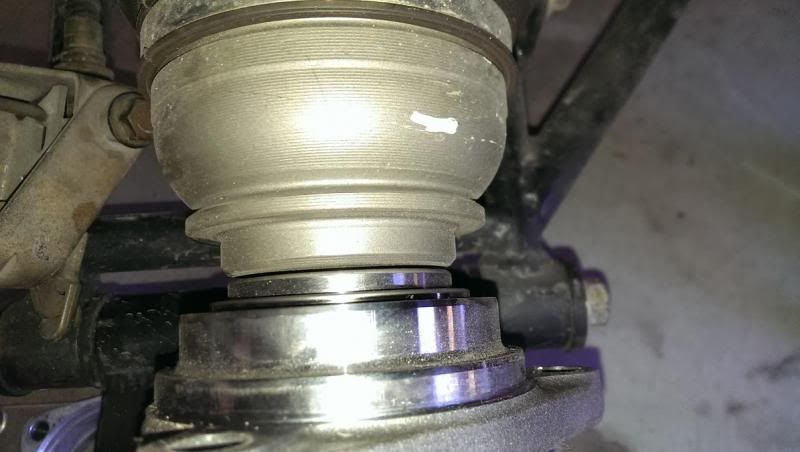
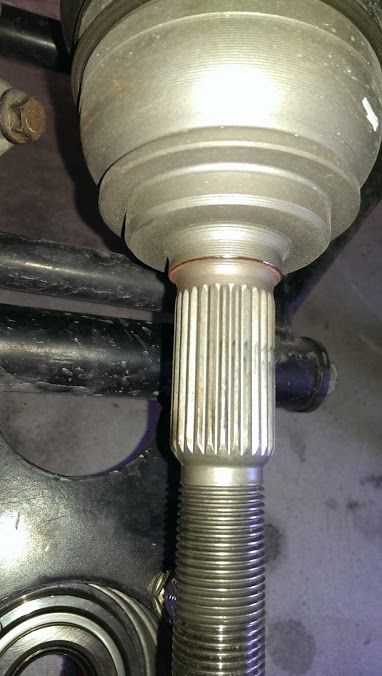
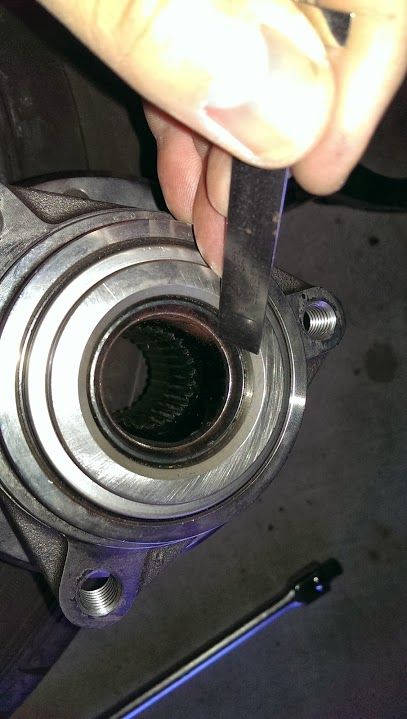
![]() Offline
Offline
While I'm posting pictures, here are a couple of the uprights. I was wrong & they are 1/2" with the extra 1/2" welded on the outboard side. That extra 1/2" wasn't originally added for strength; the guy who built it mismeasured & the control arms were hitting the inside of my wheels. That 1/2" was supposed to correct that (ended up that I still needed a 1/4" spacer.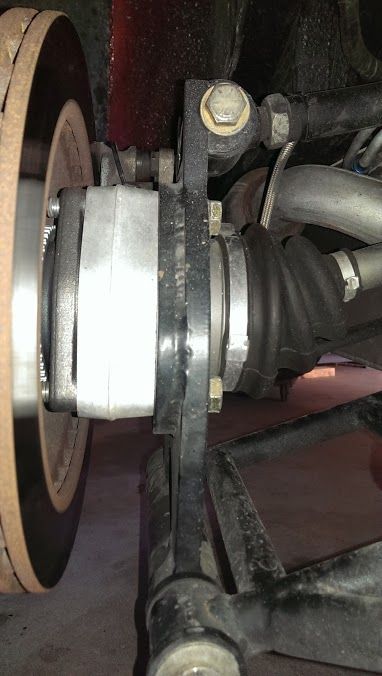
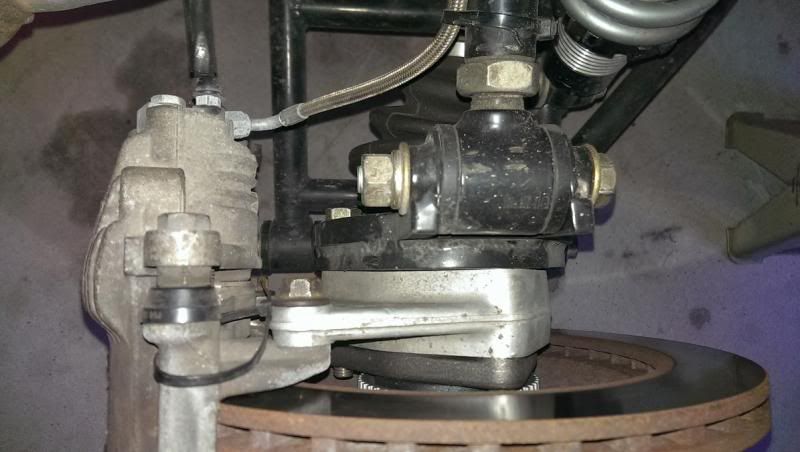
![]() Offline
Offline
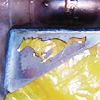
tyrellracing and Ralphy NOCK IT OFF!!!!! I love a good debate and the fact that you guys want accurate information but I am so sick of the sarcasm and jabs at each other. I just read through all your posts on this thread and you BOTH have crossed the line more than once. If you you don't nock it off I will ban you both from the forum for a month. There has been a lot of good information from both of you to help the OP but the arguing for the sake of arguing has totally over shadowed this thread. I am serious this IS your last warning NOCK IT OFF!!!!!
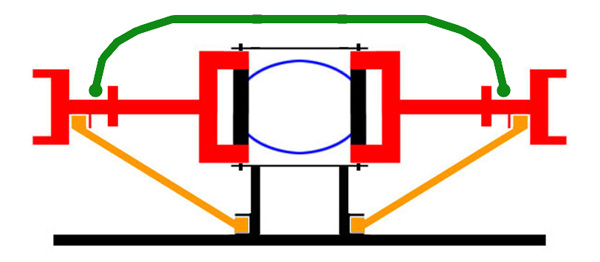
![]() Offline
Offline

I don't know if I'd throw out the LCA's. Are you talking about starting from scratch, carrier and all? At quick glance, redo the upright and pin the top of the upright in position with a new link design. Once the top of the upright is hard fixed for and aft. The coilover stays forward of the LCA. As far as the halfshafts, I would call The Driveshaft Shop. You said seven hundreths when I think you meant seven thousandths. A .007 press is so heavy you would almost not notice it being hard to pull together. What are you using to measure the diameters, use something better than calipers if thats what you used.
Do I see a step at the top of the fillet/radius at the mating surface. The fillet looks suspect from what I see also.
Ralphy
Last edited by Ralphy (1/19/2014 5:46 am)
![]() Offline
Offline

Your setup is almost the same as a T Bird or Heidts. With the exception your coilover is in front. I don't remember if you said you can't move your coilover behind your halfshaft. But if you can you may be able to only redo the upright/knuckle and move the coilover. I think you also said your not running big HP? With the coilover behind, it loads the LCA opposite of the hard throttle.
Your LCA looks way better than Heidt's!
Okay maybe, you do mean .070? Are you talking about the front leading edge of the back OD @ point 1, that is shinny? If so all you may need is to add a bigger chamfer. Looks like interference.
View #1
View #2
Arrrhhh! Maybe you want to keep these?
Ralphy
Last edited by Ralphy (1/19/2014 7:35 am)
![]() Offline
Offline
It's hard to describe Ralphy, but if you look at the stub axle picture, the threads are one diameter; lets call that section one of the axle. Then the splines are a bigger diameter, we'll call that section two. Then after the splines, the diameter bumps up again (section three) and you can see the whiney ring at the leading edge of that section. Section three is about .070 (7 hundredths, not .007) larger diameter than the inside diameter of the bearing assembly. If you look at the bearing pic, there is a similar ring scratched in that I'm pointing to with the ruler. That spot is where section three is hitting it and it is hitting on the champher inside the bearing. Modifying the champher won't help; I'd either need to turn down section three of the axle or the inside of the bearing.
My current axles are custom made, but in an earlier version I had shortened Nissan axles. The Nissan stub axle diameter and spline match the S10 which was part of what led us to the S10 bearing/hub assemblies. I checked the Nissan stub axle and it goes on all the way and seats properly.
I don't think turning the bearing out is a good idea for several reasons... Potential to get debris in the bearing, may be too hard, and, would mean I'd need machining if I had to replace a hub out on the road some day. Option two is to simply swap the current stub axles for the Nissan ones. Haven't looked to see if they are the same length and designed for the same axle diameter - but if my memory is right, the axle was smaller diameter. Last option is to turn down the current stub axle (including the radius leading to the face that mates with the flat on the back of the bearing/hub so turning down section three doesn't create a stress riser at that transition. Option two would be the fastest answer it everything lines up, but I want to talk with the place I got the axles first because I don't want to lose support from them if needed if they don't like the idea of me modifying them.
![]() Offline
Offline

I'm not there, but it looks like #1 in view #1 and #1 in view #3 are interfering. It you increase the chamfer you'll make the overall length/OAL of number diameter #3 shorter. The OAL of diameter #3 may be to long for the bearing, measure the two lengths stub axle and bearing.
View #3
I numbered the pics. In view #2 is that a gap between the axle and bearing?
Ralphy
Last edited by Ralphy (1/19/2014 7:40 am)